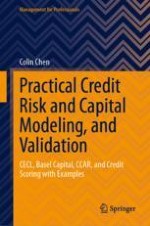2024 | OriginalPaper | Buchkapitel
3. Credit Modeling Techniques
verfasst von : Colin Chen
Erschienen in: Practical Credit Risk and Capital Modeling, and Validation
Verlag: Springer Nature Switzerland
Aktivieren Sie unsere intelligente Suche, um passende Fachinhalte oder Patente zu finden.
Wählen Sie Textabschnitte aus um mit Künstlicher Intelligenz passenden Patente zu finden. powered by
Markieren Sie Textabschnitte, um KI-gestützt weitere passende Inhalte zu finden. powered by
